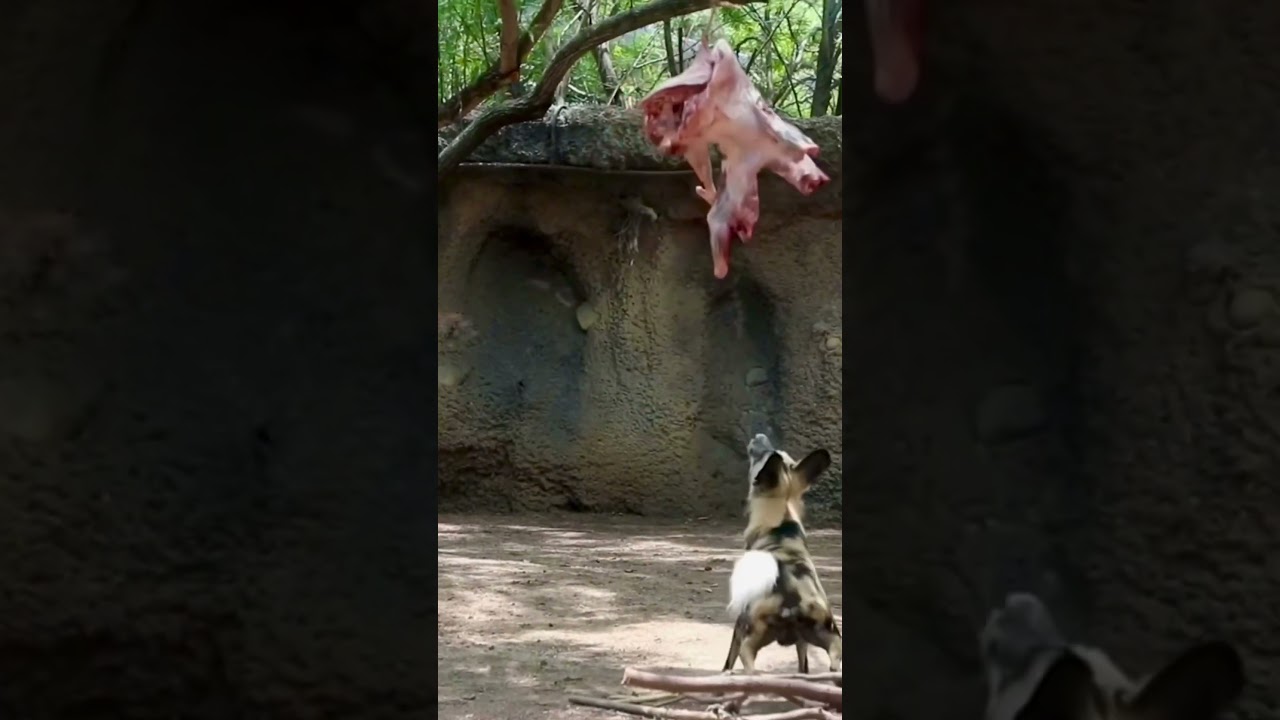– Discovering the enchanting world of painted dogs and their unique social behaviors.
– Exploring the role of enrichment practices in the health and happiness of these charismatic canines.
– Understanding the importance of conservation efforts for painted dogs, a fascinating and endangered species.
Imagine stepping into the vibrant and bustling life of a creature whose camaraderie and unique patterns are as mesmerizing as they are mysterious. The creature in question? The painted dog is also known as the African wild dog. These are not your typical domesticated friends but a species of canines that roam the African savannas and woodlands, sporting coats that look like an abstract painter’s canvas. Today, we’ll dive into the enchanting world of these animals, spotlighting a recent event that has zoo enthusiasts buzzing: the painted dogs at a renowned wildlife sanctuary received an extra special treat!
With a society as intricately woven as the painted patterns on their fur, the painted dogs (Lycaon pictus) lead lives rich with communication, cooperation, and care. In the wild, their packs are led by a dominant breeding pair, and they employ sophisticated hunting strategies that could put any military tactician to shame. Yet, these strategies are based on cooperation rather than competition, proving that unity can be a strength.
For painted dogs, every day is a testament to their survival skills and the strong bonds they share. Imagine witnessing the ritualistic greeting ceremonies that reinforce social ties or the admirable way they tend to the sick, the old, and the young; this altruism extends to the point where they will regurgitate food for those unable to hunt. These displays of social rapport are heartwarming and vital for the pack’s endurance.
Within the confines of a sanctuary, where painted dogs are given a second chance at life, the need for mental stimulation and mimicking natural behaviors is paramount. Hence, zookeepers and conservationists devise ‘enrichment’—a term used to describe activities providing mental and physical stimulation to animals in managed care. The objective? To spark these canines’ instincts and abilities, ensuring their lives are as fulfilling as possible.
One might wonder, what constitutes a ‘special treat’ for a painted dog? In truth, anything novel can be an adventure for these intelligent creatures, whether it be a new scent to track, a puzzle that holds a hidden morsel, or a change in their routine that piques their curiosity. These enrichment experiences are enjoyable for the animals and the observers—human spectators can witness the sheer joy and engagement of the dogs as they partake in these activities.
And it doesn’t just stop at fun and games; these enriching experiences replicate challenges painted dogs would commonly face in the wild, keeping their innate skills sharp. Tasks that involve foraging, problem-solving, and coordinating with their pack members are all important for the cognitive health of these canines. By fostering a thriving environment that appeals to their wild instincts, we ensure that the painted dog’s spirit remains untamed even in captivity.
Imagine the scene: a group of painted dogs eagerly anticipating what’s to come, their keen senses detecting something different in the air. It’s not an ordinary day—excitement is palpable among the pack. The special treat arrives, and it’s a sight to behold! Perhaps it’s a new type of game that not only puts their physical prowess to the test but also challenges their intellectual capabilities. Or maybe it’s a variety of food infused with unique scents that trigger an enthusiastic forage-fest. Whatever this special treat may be, it’s clear that the keepers have brought a slice of the wild into the dogs’ well-maintained habitat.
Moreover, these activities aren’t just for the dogs’ immediate pleasure; they’re also intertwined with the broader conservation goal. Educating the public about the painted dog’s plight through these interactive displays sparks an interest and a will to protect these stunning animals. And protect we must, for the painted dogs are more than just beautiful and clever—they’re a critical part of the ecosystems they inhabit.
Sadly, the painted dog is an endangered species, with numbers dwindling because of habitat loss, human-wildlife conflict, and diseases from domestic animals. Each pack that thrives under human care represents hope—a beacon urging us to learn, care, and act. Thus, Zoos and sanctuaries serve as vital conservation hubs, places where research flourishes, and breeding programs aim to bolster wild populations.
Here, we learn about the painted dog’s struggle, resilience, and the sheer power of collaborative conservation efforts. Across the globe, endeavors to protect these animals are gaining momentum, involving the translocation of packs to safer habitats, vaccination programs that shield them from disease, and conflict mitigation. Each treat and each enrichment session underscores the narrative that conservation is a daily commitment and that every small act in service of these dogs is a step toward securing their future.
As we come to the end of our journey into the lives of these fascinating creatures, let’s carry forward the knowledge that the painted dogs’ fate lies not just in the hands of the dedicated few but also in our collective consciousness. Every visit to a zoo, every share of an informative post about wildlife, and every conversation that raises awareness contribute to the conservation cause.
The story of the painted dogs, with their intricate societal structures, environmental importance, and beauty that requires no filter, begs to be told. They are not just another species in the vast tapestry of life—they are symbolic of the animal kingdom’s struggle and splendor. Through engagement, education, and empathy, we can ensure that the howl of the painted dog echoes across the savannas for generations to come. Let’s not just marvel at their beauty; let’s commit to being a part of their preservation story. Because every animal matters, every effort counts, and every heart that cares is a beacon of hope for the natural world.
*****
Source Description


